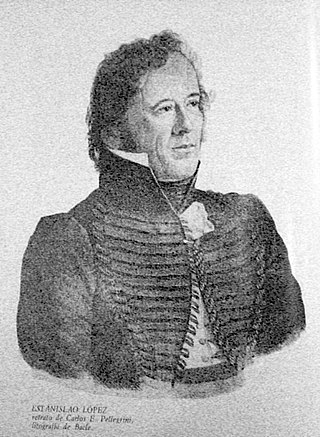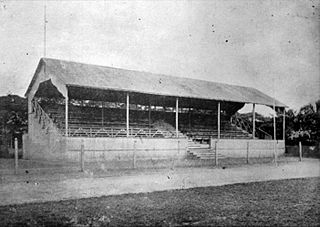Related Research Articles

Argentina is divided into twenty-three federated states called provinces and one called the autonomous city of Buenos Aires, which is the federal capital of the republic as decided by the Argentine Congress. The provinces and the capital have their own constitutions, and exist under a federal system.

Buenos Aires, officially the Autonomous City of Buenos Aires, is the capital and primate city of Argentina. The city is located on the western shore of the Río de la Plata, on South America's southeastern coast. "Buenos Aires" is Spanish for "fair winds" or "good airs". Buenos Aires is classified as an Alpha- global city, according to the Globalization and World Cities Research Network (GaWC) 2020 ranking.
Call signs are frequently still used by North American broadcast stations, in addition to amateur radio and other international radio stations that continue to identify by call signs worldwide. Each country has a different set of patterns for its own call signs. Call signs are allocated to ham radio stations in Barbados, Canada, Mexico and the United States.
In broadcasting and radio communications, a call sign is a unique identifier for a transmitter station. A call sign can be formally assigned by a government agency, informally adopted by individuals or organizations, or even cryptographically encoded to disguise a station's identity.

Estanislao López was a caudillo and governor of the province of Santa Fe, Argentina, between 1818 and 1838, one of the foremost proponents of provincial federalism, and an associate of Juan Manuel de Rosas during the Argentine Civil War. He is considered an iconic figure in Santa Fe and one of the most influential political actors in the Argentine conflicts of the 1820s and 1830s.

The Treaty of Pilar was a pact signed among the rulers of the Argentine provinces of Santa Fe, Entre Ríos and Buenos Aires, which is recognized as the foundation of the federal organization of the country. It was signed in the city of Pilar, Buenos Aires on 23 February 1820 by governor Estanislao López for Santa Fe, caudillo Francisco Ramírez for Entre Ríos, and provisional governor Manuel de Sarratea for Buenos Aires, after the dissolution of the national government caused by the Battle of Cepeda. A reference to it was included in the Preamble of the Argentine Constitution of 1853 as one of the "pre-existing pacts" fulfilled by it.

The Campeonato Argentino de Mayores was an annual rugby union competition held in Argentina for provincial teams. The Campeonato Argentino was strictly amateur, and only players from local clubs were allowed to play. It was organised by the Argentine Rugby Union (UAR), with the last season held in 2017.

Ricardo Ernesto Montes i Bradley, poet, essayist, art historian, and literary critic and diplomat born on June 9, 1905, in Rosario, Argentina. He was Honorary Consul of México in Rosario, professor of Fine Arts, publisher, columnist and contributor in newspapers and literary magazines in Latin America. R-E Montes i Bradley held Doctorates in the Law, Diplomacy, History and International Law. He was an active member of the International Institute of Ibero-American Literature and the International Association of Critics; Correspondent Member of the National Academy of Arts and Literature of Cuba and of the National Academy of History and Geography of Mexico; Honorary Member of the Mexican Academy of Genealogy and Heraldry ; member of the Sociedad Argentina de Escritores (SADE); a member of the Círculo de la Prensa and the Colegio de Abogados de la Ciudad de Rosario; co-founded the Escuela de Bellas Artes de Rosario; member of the Asociación de Críticos de México. As publisher, he was responsible for the Boletín de Cultura Intelectual, which he also directed; the art magazines Revista Paraná and Cuadernos del Litoral were also the result of his commitment to journalism in the arts. The last two publications were dedicated to promote the works of local artist, writers, poets in the region known as Paraná, Rosario de Santa Fe and vicinity.

Telefe Rosario is an Argentine open television channel affiliated with Telefe that broadcasts from the city of Rosario, province of Santa Fe. The channel can be seen in Greater Rosario and in the north of the province of Buenos Aires. It is operated by Paramount Global through Telefe Group.
The following radio stations broadcast on FM frequency 87.9 MHz:
The following radio stations broadcast on AM frequency 1370 kHz: 1370 AM is a regional broadcast frequency, on which Class B and D stations broadcast.

Avenida Santa Fe is one of the principal thoroughfares in Buenos Aires, Argentina. The artery is essential to the imaginary axis of Barrio Norte in Buenos Aires, comprising the areas influenced by the route of the avenue through Retiro, Recoleta and Palermo neighborhoods, it is considered one of the main shopping and strolling areas of the city, its many boutiques range from elegant to edgy, which has led it to be dubbed the 'Avenue of Fashion'. Upscale Alto Palermo, at Avenida Coronel Díaz, is one of the city's best-known vertical malls. Avenida Santa Fe is also an attraction for its architecture, strongly reminiscent of Paris. Its name pays homage to the eponymous province in Argentina.

Radio in Argentina is an important facet of the nation's media and culture. Radio, which was first broadcast in Argentina in 1920, has been widely enjoyed in Argentina since the 1930s. Radio broadcast stations totaled around 150 active AM stations, 1,150 FM stations, and 6 registered shortwave transmitters. An estimated 24 million receivers were in use in 2000.
Call signs in Argentina are unique identifiers for communication. Call signs are regulated internationally by the ITU as well as nationally by the Comisión Nacional de Comunicaciones of the Argentine government.
Call signs in Asia are rarely used to identify broadcast stations. In most Asian countries, broadcast stations use other forms of identification. Japan, South Korea, Indonesia, the Philippines and Taiwan are exceptions to this rule. Amateur radio stations in India, Pakistan, Korea and Japan are allocated call-signs.
Call signs in Canada are official identifiers issued to the country's radio and television stations. Assignments for broadcasting stations are made by the Canadian Radio-television and Telecommunications Commission (CRTC), while amateur stations receive their call signs from Innovation, Science and Economic Development Canada. Conventional radio and television broadcasting stations assignments are generally three, four or five letters long and almost exclusively use "C" call signs; with a few exceptions noted below, the "V" calls are restricted to specialized uses such as amateur radio.

Santa Fe is a former railway station located in the city of Santa Fe de la Vera Cruz in Santa Fe Province, Argentina. Having been closed in March 1993 after the Government of Argentina closed all the long-distance services in Argentina, the station was reopened by the local Municipality as a convention center.
Broadcast call signs are call signs assigned as unique identifiers to radio stations and television stations. While broadcast radio stations will often brand themselves with plain-text names, identities such as "cool FM", "rock 105" or "the ABC network" are not globally unique. Another station in another city or country may have a similar brand, and the name of a broadcast station for legal purposes is normally its internationally recognised ITU call sign. Some common conventions are followed around the world.
The annual consumption of beer in Argentina is about 33 litres per person.

The 1913 Copa de Honor Municipalidad de Buenos Aires was the final that decided the champion of the 9th. edition of this National cup of Argentina. In the match, held in Ferro C. Oeste Stadium in Caballito, Buenos Aires, Racing Club beat Club Atlético Estudiantes 5–1, winning its second consecutive Copa de Honor trophy. On the other hand, it was the third and last Copa de Honor final played by Estudiantes, with no success.
References
- ↑ "Radio Call Letters: May 9, 1913" (PDF). Bureau of Navigation, Department of Commerce, United States. May 9, 1913. Retrieved 2019-05-19.
- ↑ "1927 International Telecommunication Union Conference, Washington (D.C., USA)" (PDF). Archived from the original (PDF) on 2014-03-08. Retrieved 2016-01-06.
- ↑ "Connect World". Archived from the original on 2012-04-20. Retrieved 2016-01-06.
- ↑ "How to operate in Argentina". Archived from the original on 2010-05-26. Retrieved 2016-01-06.
